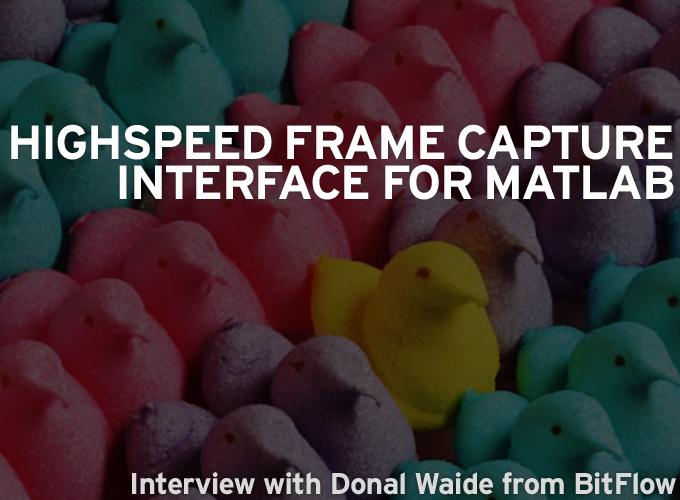CoaXpress and MatLab integration offer options where previously none existed. The ability to have a controllable high speed camera at distances greater than 7m wasn't a possibility before, without the use of extenders and other potential hardware failures.
Donal Waide | BitFlow
How long has the BitFlow MatLab interface been around?
 We have been working with MatLab for about 3 1/2 years now. The proximity of the companies makes it easy to facilitate communication between the developers.
We have been working with MatLab for about 3 1/2 years now. The proximity of the companies makes it easy to facilitate communication between the developers.
So who benefits from this upgrade?
There are a number of beneficiaries, but mainly it's the existing customers looking to upgrade and new customers looking for the latest technology in machine vision.
What is the latest technology?
This would be CoaXPress, a new asymmetric high speed point to point serial communication standard for the transmission of video and still images, scalable over single or multiple coaxial cables. It has a high speed downlink of up to 6.25Gbps per cable for video, images and data, plus a lower speed, 20Mbps uplink for communications and control. (as described on www.CoaXPress.com)
Who needs this technology?
Basically, the customers who are at the limit with Camera Link right now (~850MB/S) and need something faster to work with their MatLab image processing software.
Does this technology open up new opportunities?
CoaXpress and MatLab integration offer options where previously none existed. The ability to have a controllable high speed camera at distances greater than 7m wasn't a possibility before, without the use of extenders and other potential hardware failures. This technology should raise new opportunities in vision.
What is BitFlow's contribution?
BitFlow has always been at the forefront of frame grabber technology having being the pioneer or early adapter over the last 20 years. As a compnany who solely concentrates on one component of the vision system, we have the ability to work openly with both camera manufacturers and with software developers allowing us to offer a far superior, more adaptable product than anyone else on the market. With seven Camera Link options and now three CoaXPress options, we are are in a position to assist all our customers in the transition to next generation frame grabbers. Our commitment to the software API's shows our abilities to be universally adopted by every customer out there.
Do you see any technology breakthroughs in the near future that could change the machine vision marketplace?
CoaXPress (CXP) emerged in 2009 but it's now in 2013/4 that the difference will occur. This is because, like all technologies, a lot of adopters won't come into play until there's a large number of players in the market. Currently there are 24 different companies offering a CXP solution.
Is BitFlow working on other new projects that you can talk about at this time?
We are always looking ahead at the next technology. We have our employees on various standards committees so we can see trends as soon as people start discussing them. We are active in the older technologies also like camera link as we want to see if any changes are being made there also. As mentioned above, our three CXP frame grabbers and seven CL frame grabbers are offering the most choice of any frame grabber manufacturer these days. Customers see us as a leader in our field due to past and current experiences.

About BitFlow
Bitflow has been developing industrial frame grabbers and software for the imaging industry since 1993. We specialize in interfacing to cameras with very high data/frame rates; working in environments with complex triggering and I/O requirements; and running in applications where every CPU cycle is precious. Our software is some of the easiest to use, yet incredibly powerful and reliable. With thousands of boards installed throughout the world, into hundreds of imaging applications, we are confident that we can solve your imaging challenges.
About Donal Waide
Donal Waide is the Director of Sales for BitFlow, Inc, a frame grabber manufacturer based in Woburn MA, about 15 minutes north of Boston. Donal has been in the Boston area since he emigrated from Ireland in 1994. His career began in machine automation and has been in machine vision since 1997 when he was an integrator with an ITS company.
Donal holds a B. Eng (Industrial) from the University of Limerick, Ireland.
The content & opinions in this article are the author’s and do not necessarily represent the views of RoboticsTomorrow
Comments (0)
This post does not have any comments. Be the first to leave a comment below.
Featured Product


